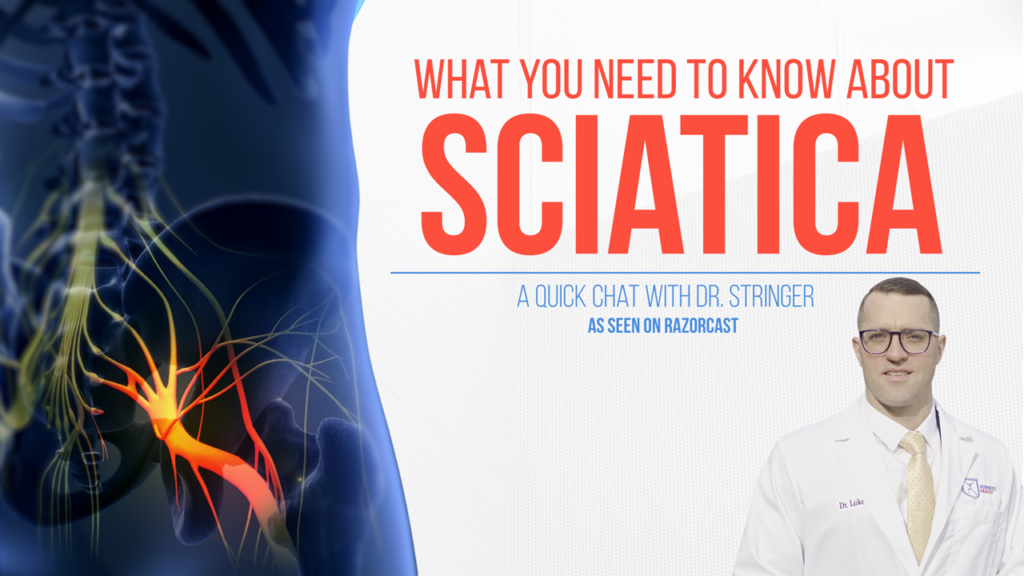
Chiropractors can help alleviate sciatica using their in-depth knowledge of how the body works and what causes pain. Here is a brief explanation of sciatica’s symptoms, causes and treatment methods.
Sciatic Nerve: There are five nerves in your low back. These nerves clump together to form the lumbar plexus, and those nerves form the sciatic nerve. The sciatic nerve is the thickest nerve in your body, as thick as your thumb.
Sciatica: Sciatic is the actual nerve, and then “a” means the nerve is inflamed. If it is true sciatica, the sciatic nerve is going to create pain out the pelvis, down through the middle of your glutes, down the back of your hamstrings, and then all the way down into your heel, your foot, and your toes. It’s typically not fun. It is intense and it is really difficult to treat. The pain radiates along the path of the nerve, which is the dermatome. If you think you’ve got sciatica and it is anything but that symptom, where it crosses into your leg or it crosses your knee or it stops at your ankle, that is not sciatica. That is nerve root impingement in the lower back.
Symptoms: When the sciatic nerve gets impinged you will get pain. It could be a sharp pain, a burning pain that radiates along the sciatic dermatome, which is down the back of the butt, down the back of the leg, and then down all the way down into the back of the leg and back of the foot. People with sciatica may also have low back pain and/or pelvic dysfunction.
Causes: Piriformis Syndrome is commonly associated with sciatica. The piriformis is a little muscle that is on the side of the hip, and it helps control, and internally and externally rotate the hip, allowing your leg to move in and out. Some people have a weak pelvic floor or no core and have poor glute function because they sit at a desk all day and their core isn’t engaging. When they play a sport like racketball, the glute muscle is engaging, and they are moving in a side-to-side motion. The little muscle, the piriformis (but there’s also six other muscles in that area that can create sciatica) gets really tight and switched on.
When muscles are getting tight, those nerves pass through a channel per se, above and in between and below. Once muscles are being overused due to compensation issues like we just discussed, those muscles are going to break down. When they break down, they get full of something called adhesion. Adhesion is like glue in a muscle. When you are bending or you are lifting your leg, that nerve should be able to floss through those structures smoothly without adhering to anything. But if we’ve got poor function in the core or the low back or the glutes, then they all work together, and those muscles get tight. Then adhesion acts like glue in a muscle and it sticks to that side now. So now, imagine you wake up in the morning, you bend over to put your socks on, and all of a sudden, it’s sticking to that structure or several other structures that it transverses through. That’s going to create tension on the sciatic nerve. That’s going to create sciatica down the dermatome.
Sciatica can also be coming from the degeneration within the spine. For example, we have five bones in our lower back. Between the bones are the discs. Discs are like shock absorbers, they absorb force. If you’ve got poor alignment from sitting all day, those discs degenerate, they lose disc space. That creates less room for the nerve to work with. The L5S1 root is the last disc in your spine. If we’ve got impingement on that nerve from a disc bulge or what we call occlusion in the nerve canal, i.e., that gets really small and it compresses the nerve, then you’re going to get that sciatic pain, that pain that refers down your butt all the way into your feet.
Diagnosis: To diagnose sciatica, chiropractors will perform a detailed history consult, spinal examination, orthopedic examination, and neurological examination. If we’re working with referral pain, we should be taking an x-ray.
What we typically see on a physical exam is just really poor, weak core muscles or overcompensating muscles in the low back and the glutes, which can create that adhesion that we just discussed.
Treatment: We need to get that joint in your lower back and your pelvis moving via adjustments. We need to work on the alignment in the spine.
Our patients can be working on lumbar lordosis in traction. They are going to be working on breaking down all the muscles that compensate in the glutes and low back through pressure point therapy, stretching, mobility work, and then obviously lots of physical therapy to address the muscle imbalances that occur in the core, in the glutes, and in the hamstrings.
When you repetitively do those things over a period of time, you can absolutely correct sciatica. Now, every case is different. We need to consider how degenerative the spine is. Was there a huge trauma that blew the disc out? Has this been an issue for 10 years? Sciatica is a really difficult condition to treat however, we get really good results here at the office.
